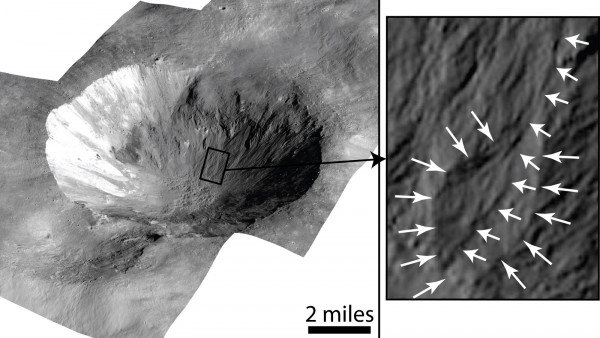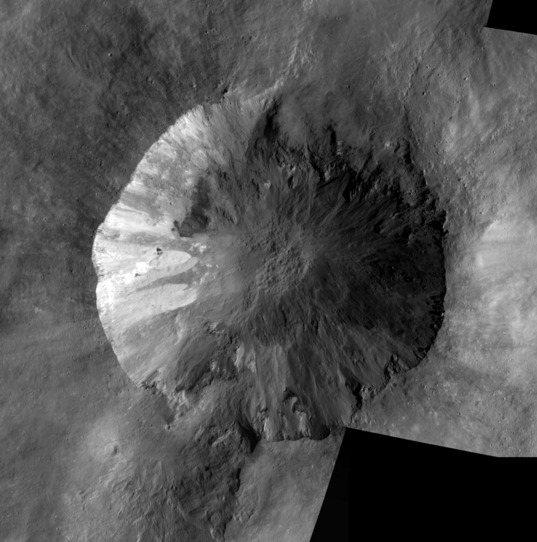
Fascinating news this month about asteroid 4 Vesta – fourth asteroid to be discovered and second-most-massive asteroid after the dwarf planet 1 Ceres. NASA’s Dawn spacecraft visited Vesta from 2011 to 2013, and the new study is based on evidence from Dawn. The new study shows that – although Vesta was once assumed to be completely dry, incapable of retaining water because of the low temperatures and pressures at its surface – there’s evidence that Vesta may have had short-lived flows of water-mobilized material on its surface. Wow, yes?
Jennifer Scully, postgraduate researcher at the University of California, Los Angeles, who conducted the research, was quoted in a January 21 press release from JPL saying:
Nobody expected to find evidence of water on Vesta. The surface is very cold and there is no atmosphere, so any water on the surface evaporates.
We’re not suggesting that there was a river-like flow of water. We’re suggesting a process similar to debris flows, where a small amount of water mobilizes the sandy and rocky particles into a flow.
Publishing in the journal Earth and Planetary Science Letters, Scully and colleagues used images from the Dawn spacecraft to identify a small number of young craters on Vesta with curved gullies and fan-shaped (lobate) deposits.

Scientists see similar features on formed by debris flows on Earth and Mars. On Vesta, the gullies are fairly narrow, on average about 100 feet (30 meters) wide. The average length of the gullies is a little over half a mile (900 meters). Cornelia Crater, with a width of 9 miles (15 kilometers), contains some of the best examples of the curved gullies and fan-shaped deposits.
The press release said:
The leading theory to explain the source of the curved gullies is that Vesta has small, localized patches of ice in its subsurface. No one knows the origin of this ice, but one possibility is that ice-rich bodies, such as comets, left part of their ice deep in the subsurface following impact. A later impact would form a crater and heat up some of the ice patches, releasing water onto the walls of the crater …
It appears the water mobilized sandy and rocky particles to flow down the crater walls, carving out the gullies and leaving behind the fan-shaped deposits after evaporation. The craters with curvy gullies appear to be less than a few hundred million years old, which is still young compared to Vesta’s age of 4.6 billion years.
The Planetary Society’s Emily Lakdawalla described it even better, when blogged about this same work from this same astronomer last March, after hearing Scully speak at the Lunar and Planetary Science Conference in Houston. At the time, she said she found the idea “intriguing but not entirely convincing.” As always, though, despite any skepticism, she did an awesome job depicting the process:
… imagine an asteroid collision, and the slow-motion excavation of a crater (slow because of the relatively low gravity), and the impact shock flashing an icy deposit into water, and it springing and tumbling down the slumping wall of the crater mixed with the cascading debris of the crater wall, the surface steaming all the way (because it’s in a vacuum), all of this silent (because it’s in a vacuum), the debris filling the new crater’s floor, still steaming at the top while freezing toward the bottom. Periodically, rarely, a hole appears in the floor, sediment draining downward, as escaping vapor leaves a void behind.
Read Emily Lakdawalla’s March 2014 blog post on this subject here.
UCLA’s Christopher Russell, principal investigator for the Dawn mission, said:
These results, and many others from the Dawn mission, show that Vesta is home to many processes that were previously thought to be exclusive to planets.
We look forward to uncovering even more insights and mysteries when Dawn studies Ceres.
After breaking out of orbit around Vesta, the Dawn spacecraft began heading toward the dwarf planet Ceres in 2013. It is now on approach to Ceres and will be captured into orbit around it on March 6, 2015. Soon, space scientists will have both Ceres and Vesta to contemplate! Should be very, very interesting.


Bottom line: Who knew asteroids could have flowing water? They are so small, airless and cold that the idea seems surprising, to say the least. But the evidence is there – in images of asteroid 4 Vesta, obtained by the orbiting Dawn spacecraft from 2011 to 2013 – for flowing water of Vesta’s surface.











